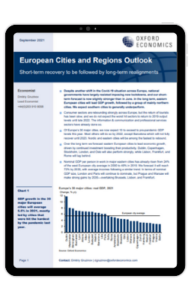European cities short-term recovery to be followed by long-term realignments

Despite another shift in the Covid-19 situation across Europe, national governments have largely resisted imposing new lockdowns, and our short-term forecast is now slightly stronger than in June. In the long term, eastern European cities will lead GDP growth, followed by a group of mainly northern cities. We expect southern cities to generally underperform.
What you will learn:
- Consumer sectors are rebounding strongly across Europe, but the return of tourists has been slow, and we do not expect the worst hit sectors to return to 2019 output levels until late 2022.
- Of Europe’s 30 major cities, we now expect 10 to exceed to pre-pandemic GDP levels this year.
- Over the long term we forecast eastern European cities to lead economic growth, driven by continued investment boosting their productivity.
{% video_player “embed_player” overrideable=False, type=’scriptV4′, hide_playlist=True, viral_sharing=False, embed_button=False, autoplay=False, hidden_controls=False, loop=False, muted=False, full_width=False, width=’1920′, height=’1080′, player_id=’56977904197′, style=” %}
Tags:
Related Services

Post
Food prices to bottom out in 2024, risks skewed to upside
Our baseline forecast is for world food commodity prices to register an annual decline this year, in aggregate, reducing pressure on food retail prices further downstream. However, we believe the risks to this forecast are overwhelmingly skewed to the upside.
Find Out More
Post
Battery raw material prices to recover
Battery raw materials prices bottomed out last quarter and we think a sustained recovery is looming. Midstream EV battery manufacturing activity has picked up again and inventories have returned to historical levels, suggesting upstream demand for raw materials will also bounce back.
Find Out More